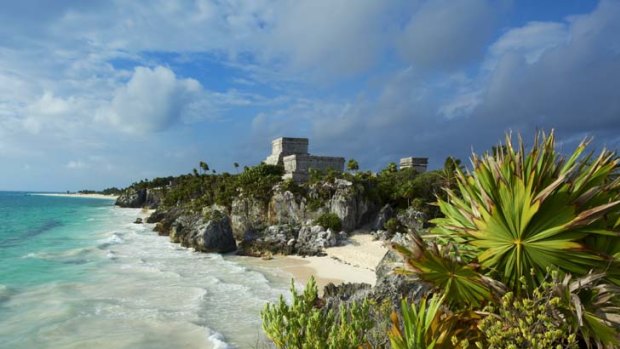
Sands of time ... Mayan ruins overlook an expanse of white beach.Credit: Getty Images
Tulum's beaches and Mayan ruins are drawing a new crowd to the Yucatan Peninsula, writes Mick Brown.
THEY have built a cycle path since I was last in Tulum, two years ago - a smooth, broad strip of concrete that runs for a few miles alongside the road from the town to the beach.
A cause of considerable civic pride, heralded by a sign on the main highway approaching the town from Cancun, the path is undoubtedly a boon for both locals and visitors but it carries more ominous portents.
Halfway along, a broad drive cuts into the jungle, marked by a small, glass-sided bungalow: the sales office for a forthcoming development, Aldea Zama, promising condominiums, hotels and shopping plazas. Outside town, they are breaking ground for an airport and there is talk of a golf course. In short, it could be the beginning of the end.
The southernmost point of Mexico's so-called Riviera Maya, Tulum was little more than a dusty hamlet 10 years ago, a magnet for backpackers drawn by the Mayan ruins that perch in a spectacular position on a cliff overlooking the Caribbean and an expanse of white beach as beautiful as any in the world. Accommodation was to be found only in a couple of thatched cabanas on the beach and a handful of modest pensions in town.
From Cancun to Playa del Carmen, the road is now lined with enormous resort complexes but the plague has yet to reach Tulum. The buses carrying day trippers to the Mayan ruins turn off before reaching the town and few venture onto the beach, where throughout the day fishermen land their catch under a cloud of circling frigatebirds.
Further south the cabanas are more luxurious, all offering spa treatments, yoga and "eco-friendly" surroundings (a euphemism for solar power: mains electricity has yet to reach this far) - hedonism with a spiritual-lite coating and prices to match. Coqui Coqui is chicest of all.
It is a paradise that could be anywhere in the Caribbean. No Mexicans live on the beach and some visitors don't bother to venture into the town, which is their loss.
Tulum is not particularly pretty but it has a ramshackle, bohemian character - a main strip more than a kilometre long lined with buildings of mongrel shapes and sizes. There are restaurants, bars and change booths. But the streets are quiet and the shops (selling pottery, bright blankets and trinkets stamped with images of Mexico's two national symbols, Our Lady of Guadalupe and the secular saint Frida Kahlo) are markedly short of custom.
According to a cook at my hotel, Drew, the fear of swine flu almost killed the tourist trade two years ago. More recently, fear of drug-related murders has been keeping visitors away, although Tulum strikes me as one of the most placid places on Earth. The occasional glimpse of an open truck, laden to the gills with armed militia, might be taken as a symbol of reassurance.
The indigenous Mayan people are by nature reserved, somewhat aloof. They are small, the women the size of children - so tiny that, when sitting on the benches in the small park outside the Palacio Municipal, their feet don't touch the ground.
The homes on the backstreets are utilitarian, brick squares in pastel colours, usually with a smallholding attached - a few chickens and, perhaps, a goat.
At the far end of town the pavement runs out, giving way to a rough strip of gravel and overgrown grass; the tourist businesses are replaced by auto-repair shops, a supermarket, hole-in-the-wall chicken joints and enterprises of a more uncertain nature.
In one building, three dusty mannequins stare out eerily from a first-floor, plate-glass window; on the floor above stands a life-size model of Our Lady ringed with electric light bulbs. Further down the road is Bar Bob, an establishment where the bas-relief sign of two grotesque cartoon figures, a grinning gorilla and a busty brunette in a bikini, leaves little room for ambiguity.
Keep walking and at length, as the town fades to darkness, you come to Tulum's great find: A small roadside restaurant, open-fronted, with plastic chairs and metal tables on a cement floor.
Locals queue for a table. As you wait, a van arrives and two men manhandle groupers into the kitchen - one-metre-plus-long fish fresh from the beach. Dinner.
It's the best food you will taste in Mexico, washed down with the local beer for about $11 a head.
You will only get the name out of me on pain of death. Some things you just don't want to change.
Trip notes
Getting there
United Airlines flies daily from Sydney to Los Angeles with connections to Cancun, Mexico. 13 17 77, unitedairlines.com.au. Hire cars are at the airport. Buses to Tulum leave daily from downtown Cancun (corner of Avenida Uxmal and Avenida Tulum).
Staying there
The beachfront Azulik Villas start from $US260 ($245) a night (low season, May-November). +54 11 5984 1575. azulik.com.
Coqui Coqui has suites from $US230 a night. +52 1 985 8565 129, coquicoquispa.com.
Sign up for the Traveller Deals newsletter
Get exclusive travel deals delivered straight to your inbox. Sign up now.